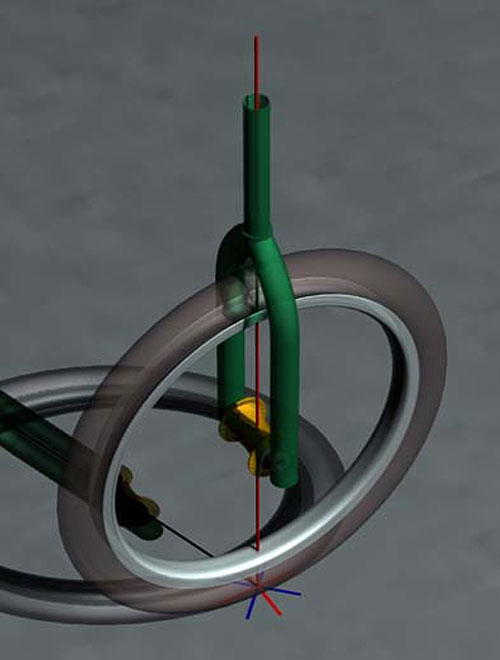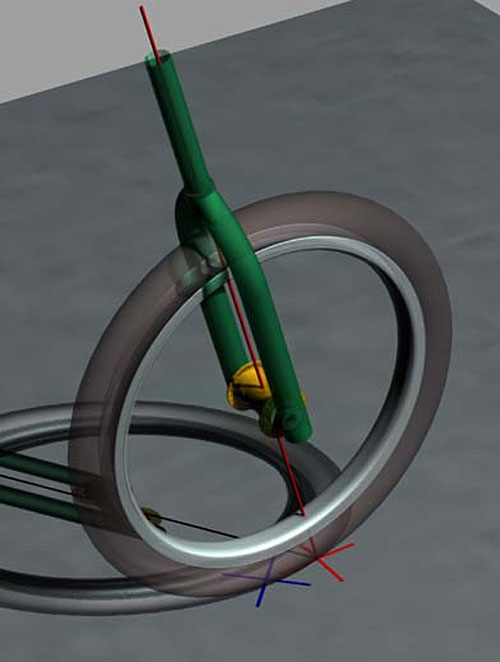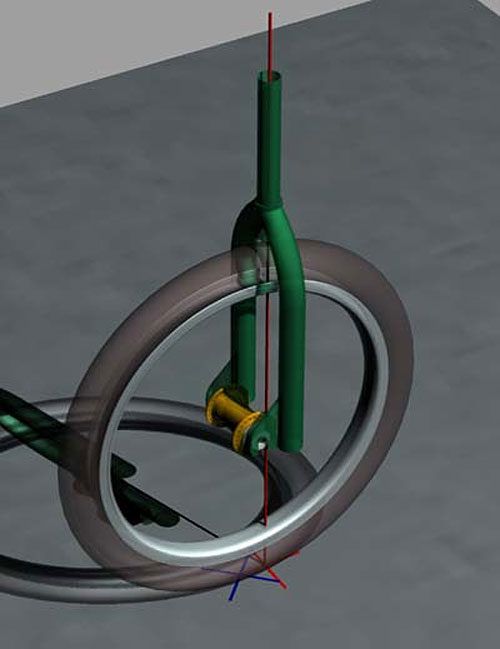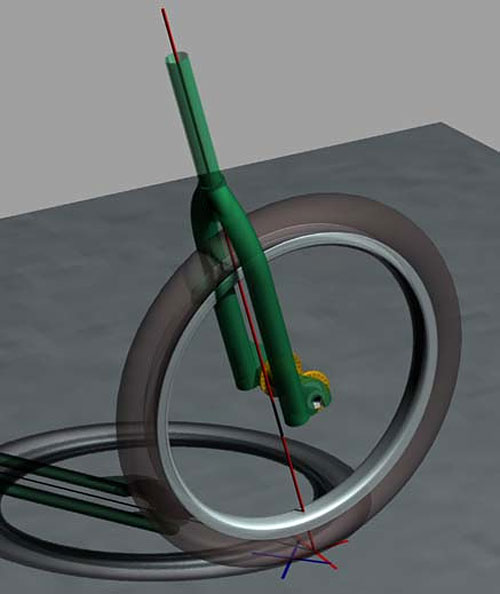Steering Geometry
*This article first appeared in Ride UK (#76) and is reproduced here by kind permission of Ride UK.
Someone requested that I do a tech column on head angles and steering geometry. I wasn’t sure at first if this was a worthwhile subject, after all, there isn’t that much variation available is there? Most frames have a head angle of 74 and a half! Degrees and most forks have one and a quarter inch legs with dropouts that stick out just enough to get a peg on.
Granted the odd frame has a 74 or 75 degree head angle and there are so called “flatland” forks that have less rake but by and large they are all the same… or are they?!? Dun-dun-durrr (dramatic/sinister drum roll).
To understand what is going on with steering geometry we are going to need a picture or two. There are two main controls over steering feel. The one we are all familiar with is head angle and the other is fork “rake” or off-set.
The key thing to look at it is the red line. This is the “steering axis” it runs through the centre of the headset bearings and is the imaginary line round which all the steering components turn. OK maybe I am dumbing this bit down a bit too much, but it is crucial that we get this part clear. The head angle is the angle this line makes with the ground.
Notice how the “head-angle” is measured relative to the ground; not relative to the top or down tube or any other part of the frame at all, only relative to the ground. This is fairly obvious, but when you take the time to think about it you realise that this means that all sorts of parts that are nothing to do with the frame CAN and WILL influence the head angle.
Stick an old school 1.75” freestyle tyre on the back, and compared to a 2.2” knobbly up front, you might lower the back end by over half an inch. On a typical bike that half inch will translate into a change in the head angle of 0.8 degrees, so your quoted 74.5 head angle becomes 73.7 !!!! Tyre size isn’t the only factor that will alter the head-angle; different forks have different specifications for the distance from axle to headset, and some headsets are thicker than others.
Add together the effects of tyres, forks and headsets and your head-angle could be over a degree off the maker’s original intention! Yet another factor to consider is whether your frame even has a 74.5 degree head angle to start with!
Everything that is ever made is subject to variation, even the most precisely made components are given a tolerance within which they can vary; a 20mm bearing is very precisely made but it is still allowed some leeway, so it might be as big as 20.01mm. Bearings are precision ground to size; bike frames are (relatively) roughly machined tubes welded together. Welding always produces some level of distortion so you can bet that no two frames have precisely identical head-angles.
74 and a half degree is a pretty specific size; over a 4 inch long head tube the end of the tube only has to wonder off by under half a millimeter to change the head angle by quarter of a degree. It is therefore pretty likely that most mass produced frames aiming for a 74.5 degree head angle will actually be anywhere from 74.25 to 74.75 and perhaps even further afield…
Bollocks, burnt my pizza… anyway, where was I?
Oh yes. So petty as it may seem, these variables mean that a new fork or tyre or headset can feel more different than you might have expected. Treat yourself to a new frame and parts that should have the same head-angle and it may surprise you how different it can feel.
So now I have convinced you it is worth thinking about, lets get back to it.
Now imagine we have a weird frame with a 90 degree head angle and “zero rake” forks. That would look like this (fig.1.).

On our example vertical head-tube frame with no rake you can imagine that as you turn the bars everything rotates around that red line, and since that red line also passes through the point where the tyre meets the ground (marked with the red cross), we would have what is called neutral steering with no trail.
Now lets imagine a normal frame with say a 74 degree head angle, but still with “zero rake” forks (fig.2.).

As before all the steering parts “orbit” around the red line, but now you can see that the effect of leaning the head-tube back has been to move the point where the red line meets the ground so it is ahead of the tyre’s “contact patch” (blue cross). This creates what is called “trail”. The tyre “trails” behind the steering axis so creating some stability. This is kind of like the rudder on a boat trailing behind and kept central by the drag of the water. In the same way; as we ride along, the drag on the tyre tries to keep it as far behind the steering axis as it can, this makes the steering tend to self straighten.
But, we could get this same effect with the vertical head angle just by having the wheel off-set backwards a bit (fig.3.).

So why don’t we?
Well there is another factor to think about… By leaning the head angle back we create stability not just through “trail” but also through the effect of gravity. With a reclined head angle and forward offset dropouts (fig.4.) we can create a situation where the rake on the forks causes the front end of the bike to lift slightly as you steer.

In much the same way that water flows to the lowest available level so too your weight on the bike tries to settle down. With the forks turned, the bike isn’t as low as it could be so the effect of your weight is to straighten the steering. This can be pretty hard to see so let me put it another way.
If you turn the bars through 360 degrees the bottom of the tyre would sweep a circle, but this circle would be perpendicular to the head-angle not flat to the ground. The back of this circle would be below ground level by a fair bit. Obviously we cant have that so the front of the bike has to rise up to allow it. If the bike lifts then you lift, so to turn the bars 180 degrees you might have to lift the front end of the bike by an inch or so. Equally if you let the bars return to straight forward the bike drops… just like water flowing down hill this is a more stable situation so it will tend to this position.
These two effects work together to create steering stability, but while the trail only works when you are in forward motion, the laid-back head-angle-effect is independent of speed or direction.
This summarises how the steering works but we also need to bear in mind that leaning the head angle back and adding rake both work to increase the overall length of the bike too. This will obviously make the balance point for front wheel tricks different but there is also the effect this has on the bikes rotational inertia (how hard it is to do a 360 say) and the much more confusing gyroscopic effects.
Over the years we have settled to the small range that our bikes currently make use of. We like a small amount of trail and so reasonably quick and responsive steering and we like how the other factors work out at this position.
Some flatlanders like a fork with less rake, by looking at these diagrams you can see that this results in more trail and so more speed stability, but less gravity based stability, so at low speed this can seem “twitchier”.
So what earthly use is all this to you? Probably none, but although it is easy to think that these small adjustments make very little difference the truth is that any slight change is very noticable.
While in some ways it is ridiculous to specify a head angle accurate to half a degree when it probably isn’t made within much less than a quarter degree of target we might as well aim for the ideal. At the end of the day steering feel is always going to be a very personal choice. Hopefully the above twaddle will help you choose your next frame or fork with a bit more certainty about how it will ride, and even cross your mind when buying a headset or a pair of forks or even just a tyre.
As we the riders take control of our sport these are the things we may want to know, maybe in the future fork manufacturers will declare the fork leg length (centre of dropout to bottom of headset) so that we can know how it will effect the steering feel…. Then again maybe we wont be that arsed…


